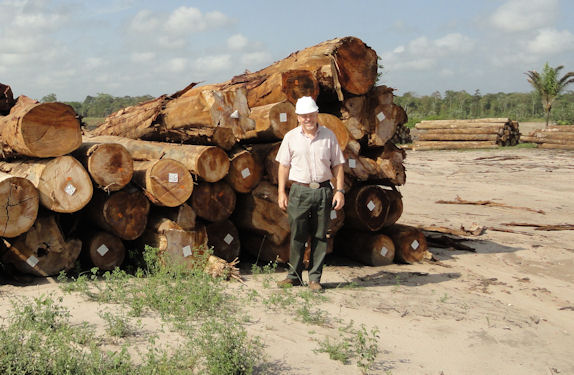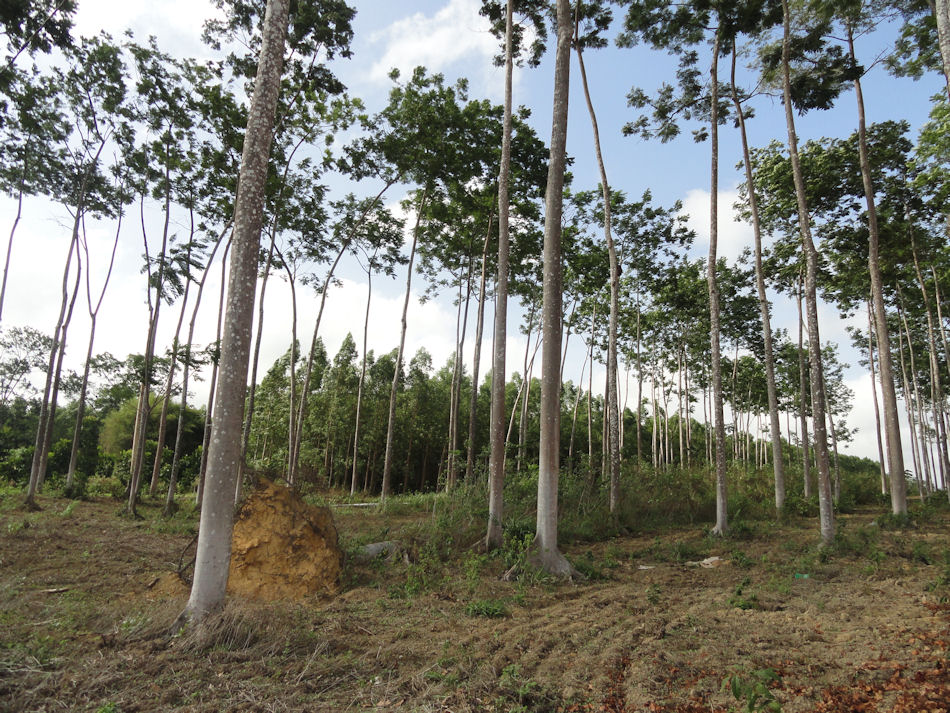
Many of the businesses around Paragominas are family owned, with generations of family members working there. The small sawmill in the picture above is family owned and so is the multimillion dollar wood processing and forestry operation farther down. I think this has to do with the pioneer nature of the society. The founders – or more likely today grandfathers – came to this place and set up shop. They have often gone through several cycles of business. There were shortages of people they could trust, with the proper skills to run the businesses, so they made their own.
The saw mill has been here for many years. The logs come up the river and are processed at this and other nearby mills in the town of São Miguel. All the logs processed here are certified. You can see the markings on each one. It is a specific number so the wood can be traced.

The Floraplac MDF plant is in a different business. They make fiberboard and wood products and require smaller trees that can be chipped and/or pulped. Originally, the factory used naturally occurring timber. But in the early 1990s, the owners saw that this would not be sustainable and started to plant their own. This created the need for different machines. Logs from the forest primeval tended to be big and differentiated. Those from plantations are smaller and uniform. The latter are easier to process, which is another benefit of plantation tree farming.

Some of the trees are a native Amazon species called paricá. This tree grows to harvest in around nine years. You can see the picture above. The wood is good and worth more per pound that eucalyptus, but eucalyptus produces more pounds per acre and has a shorter rotation of only seven years. There is need for both but the eucalyptus is often more useful, if less popular because of its non-native status.

There are hundreds of species of eucalyptus, so the variations are almost endless. Eucalyptus is native of Australia, but there are probably more types of the trees and more trees in Brazil than anyplace else in the world. Vitorio is constantly seeking to improve the genetic stock and silviculture of his trees. For example, some suffer from rot when there is too much humidity and they are now planting crossbred trees that are resistant. They are in a perpetual arms race with bugs and diseases. This is the way of nature, especially when you have large areas of very similar trees.
As I have written before, I am a little sad that eucalyptus has replaced pine over the warmer parts of Brazil. Pine is also an invasive species here, but it is familiar to me. I like the eucalyptus trees, but pine are more the woods of home. But where eucalyptus can grow well, pine cannot compete in the pulp & chip market. The eucalyptus has a nice scent, kind of a fresh mint. I still, however, prefer the pine.
Floraplac is a vertically integrated operation of a type we see increasingly rarely in the U.S. They own the land and grow the trees they use to supply their operation. During the 1990s anon most American pulp, paper and timber firms sold their land to smaller holders and timber investment management organizations (TIMOs). This is how I got my forest land. Companies figured that they did not have to bear the carrying costs and risks involved in growing the trees and owning the land. They could rely on private owners. The additional transaction costs were low compared to the carrying costs.
Brazil is not ready for this just yet. There are probably not enough private owners for all the land around here needed to supply the plant. I asked Vitorio about this model. He said that they are trying to source some timber from smaller holdings, but these were not people engaged in forestry, as they might be in the U.S. Rather they were doing a kind of silvopasture or woodland agriculture, where they would raise stock and/or crops among and between the trees. The forestry would provide a supplement to their income but not in itself be a viable investment.
Buying from small holders is not the most profitable business possible. Floraplac does it as part of its commitment to the community and corporate social responsibility. It is smart business in the long run. At some point in the future, there might be calls to move the plant or criticism of its use of forest resources. At the time, it will be good to have a significant group of people who better understand sustainable forestry and are connected by their own interests to the continued viability of the enterprise.
They were down to earth, friendly people. The multigenerational nature of the business ensures that they look to the future. It seems to me a really great business and an admirable business model, so far removed from the caricature of people showing up in the forest to make a quick buck and a quicker exit. People here are in it for the long run.
